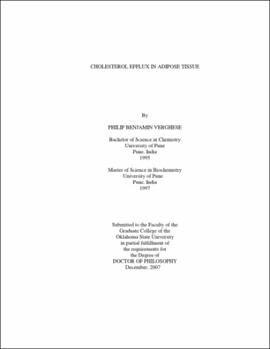| dc.contributor.advisor | Soulages, Jose L. | |
| dc.contributor.author | Verghese, Philip Benjamin | |
| dc.date.accessioned | 2013-11-26T08:23:00Z | |
| dc.date.available | 2013-11-26T08:23:00Z | |
| dc.date.issued | 2007-12 | |
| dc.identifier.uri | https://hdl.handle.net/11244/6681 | |
| dc.description.abstract | Scope and Method of Study: | |
| dc.description.abstract | The current studies are important to understand the reverse cholesterol transport (RCT) in vertebrates. Reverse cholesterol transport is the process by which excess unesterified cholesterol is transported from peripheral tissues to the liver for excretion from the body. Several lines of evidence suggest that defects in RCT contribute to the development of atherosclerosis. Adipose tissue constitutes a major site of cholesterol storage and it may play a role in the regulation of circulating cholesterol levels. The understanding of metabolic link between the lipolytic state (hydrolysis of triacyglycerol) of adipocytes and the mechanism of release of cellular cholesterol to external cholesterol acceptors like apolipoprotein A-I (apoA-I) and high density lipoprotein (HDL) is necessary to elucidate the role of adipose tissue in whole body cholesterol homeostasis. | |
| dc.description.abstract | Findings and Conclusions: | |
| dc.description.abstract | Our study shows that β-adrenergic activation of the lipolysis significantly increases the extent of cholesterol efflux to reconstituted discoidal HDL particles. The enhancement of cholesterol efflux is not due to the enrichment of plasma membrane cholesterol, or to the levels of the cholesterol transporters ABCA1 and SR-BI. The activation of lipolysis is accompanied by an increase in BFA-sensitive vesicular transport that in turn enhances cholesterol efflux to HDL. The study supports a metabolic link between the lipolytic activity of adipocytes and the rate of cellular cholesterol efflux to HDL. The activation of lipolysis does not induce a significant increase in the rate of cholesterol efflux to lipid free apoA-I. The known vesicular and non-vesicular cholesterol efflux inhibitors inhibit global cholesterol efflux significantly, but not specific cholesterol efflux to apoA-I. We have evidently presented that lipid free apoA-I undergo retroendocytosis in mouse adipose cells, human liver cells but not in human macrophage cells. The known cholesterol efflux inhibitory drugs had no effect on the uptake and recycling of apoA-I. | |
| dc.format | application/pdf | |
| dc.language | en_US | |
| dc.rights | Copyright is held by the author who has granted the Oklahoma State University Library the non-exclusive right to share this material in its institutional repository. Contact Digital Library Services at lib-dls@okstate.edu or 405-744-9161 for the permission policy on the use, reproduction or distribution of this material. | |
| dc.title | Cholesterol efflux in adipose tissue | |
| dc.contributor.committeeMember | Yu, Chang-An | |
| dc.contributor.committeeMember | Matts, Robert L. | |
| dc.contributor.committeeMember | Dillwith, Jack W. | |
| osu.filename | Verghese_okstate_0664D_2490.pdf | |
| osu.accesstype | Open Access | |
| dc.type.genre | Dissertation | |
| dc.type.material | Text | |
| dc.subject.keywords | high density lipoproteins | |
| dc.subject.keywords | apolipoprotein a-i | |
| dc.subject.keywords | cholesterol efflux | |
| thesis.degree.discipline | Biochemistry and Molecular Biology | |
| thesis.degree.grantor | Oklahoma State University | |
